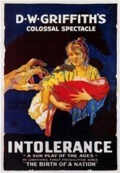Film review by Jason Day of Intolerance: Love’s Struggle Throughout the Ages, the epic silent movie directed by D.W. Griffith and starring Mae Marsh and Robert Harron.
Silent

To like this post, comment on it or follow this blog, please scroll to the bottom. Use the search function on the left of the screen to look for other reviews and updates.
Synopsis
Four stories connected by an image of a woman (Gish) eternally rocking her baby are intercut to tell how love struggles against the intolerance of others. In ancient Babylon, a mountain girl (Talmadge) sold as a slave gets caught up in the tumult of war. In Judea, Jesus is betrayed by a group of hypocritical Pharisees. Paris, 1572 and a young Hugenot couple prepare to marry unaware of the St. Bartholomew’s Day massacre about to engulf them. In modern times, a poor young girl (Marsh) and her beloved (Harron) are harassed by social do-gooders and an envious neighbour (Cooper).
Review, by Jason Day
Although misunderstood and largely ignored outside of the big US cities on its initial release, Intolerance is now remembered for its humungous running time (around 3 hours, when most films released would have run to about an hour), the mammoth impact and influence it had on other film-makers, it’s epic production values (and consequent cost that would curtail its maker for some time to come) and the huge role-call of future Hollywood talent employed in small acting or behind the scenes roles.
The film was intended as director Griffith’s personal response to critics of his previous epic The Birth of a Nation, a film that was overtly supportive of the Ku Klux Klan and criticised for its racist and incendiary tone and whom he felt were curtailing his right to artistic expression (Griffith was the son of a noted Confederate soldier during the American Civil War).
Of Nation, enough has been said, but there is no doubt Intolerance is an exceptional, ambitious and stunning if not always successful piece of film-making, not merely in terms of narrative scope but also as a technical, cinematic endeavour with judicious editing, expensive sets and costumes, adventurous camera-work that includes a thrilling early crane shot as we swoop into the revelry of ancient Babylon and Griffith’s increasingly mature direction of his actors.
Griffith had slogged away at the old Biograph studios for years churning out hundreds of short subjects that grew in technical sophistication, developing techniques such as using close-ups to show emotion, cross-cutting between scenes for suspense, using ‘irises’ to focus on action and fading away to leave a scene. This film, like Nation, brings together all of these to create a complete, modern ‘film’ that some critics cite as the only film ‘fugue’ (a compositional term used in classical music, in which two or more ‘voices’ built on a theme repeat themselves).
As a master of editing, Griffith had no peers at this time and the final moments, a frantic escalation of action where all 4 stories intertwine (most memorably with Marsh saving her lover from the scaffolds) are still excitingly realised.
Griffith’s stock company of actors are all mostly in check, but the two that matter the most here are Marsh and Talmadge, both of whom are now remembered for these turns. Talmadge, in particular, is sparky and independent as the mountain girl and her scenes proved so popular with audiences that Griffith edited them together and filmed a new ending and released the whole thing as a separate film (The Fall of Babylon).

Still of the revelry in ancient Babylon before its destruction. Intolerance (1916). Restored by Nick & Jane for Dr. Macro’s High Quality Movie Scans Website: http:www.doctormacro.com
The main problem with the film, today as well as then, is that Griffith’s reach extends his grasp. He cannot control four stories with equal verve so, consequently, the middle two stories suffer from a lack of exposure and jar the flow of the film (Babylon and the modern story are clearly the focuses). Cutting them out and reducing the meandering length of the film might have helped, but he is to be admired for trying to tackle several thousand years of history in one movie.
But Intolerance’s legacy cannot be underestimated.
In post-revolution Russia, with a parlous film industry, young film-makers cut the massive amount of footage and re-edited the scenes together to produce new meanings between scenes. Thus was born the montage cinema of Eisenstein and Virtov (that would influence other film-makers such as Hitchcock, who would go on to influence just about everyone else).
The cast and production credits list directors such as Raul Walsh, Frank Borzage, Todd Browning, W.S. Van Dyke, King Vidor, Erich von Stroheim, Allan Dwan, Victor Fleming and actors like Donald Crisp, Douglas Fairbanks and Wallace Reid, all of whom would gain invaluable experience of film-making here and take this with them into a young Hollywood.
It is for these reasons that this film, at times unwieldy and draining, yet so spectacular it burns into the memory, fully deserves its place in cinema history.
Cast & credits
Director: D.W. Griffith. 197mins (US edit). Triangle Film Corporation/Wark Producing.
Producer: D.W. Griffith.
Writer: D.W Griffith.
Camera: G.W. Bitzer.
Music: Carl Davis (1986 reissue).
Sets: Walter Hall, D.W. Griffith.
Mae Marsh, Robert Harron, Constance Talmadge, Elmer Clifton, Alfred Paget, Seena Owen, Margery Wilson, Eugene Pallette, Miriam Cooper, Walter Long, Lillian Gish, Bessie Love, Spottiswoode Aitken, Josephine Crowell, Joseph Henabery, Tully Marshall.

